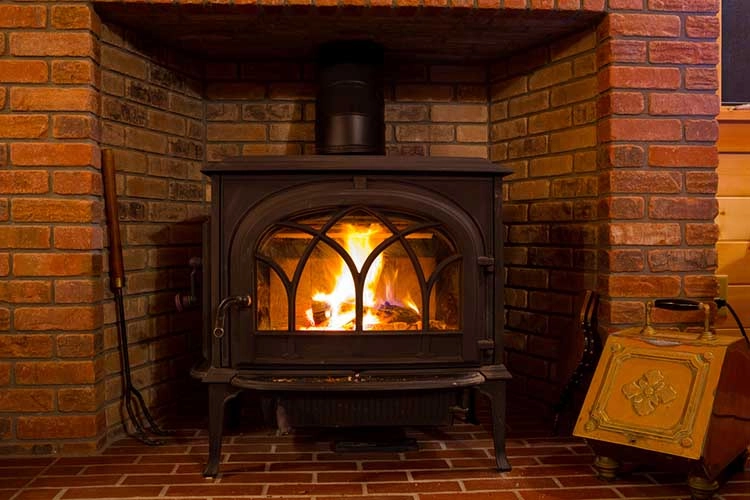The fire’s crackling as snow falls outside. You’ve got a warm cup of hot cocoa in hand and are wrapped under a favorite blanket watching the flames in your wood-burning stove. There is nothing quite so relaxing and cozy as enjoying a wood fire.
While having a wood-burning stove can provide many nights of comfort and warmth, make sure you maintain your stove property so you keep your home and family safe.
We make it easy with 7 tips for maintaining your wood-burning stove.
The Pros of Wood-Burning Stoves
Before jumping into maintenance, let’s cover what makes them so great to own.
Pros:
- When properly maintained, a wood-burning stove is attractive and can add a lovely warmth to your home.
- Sustainably harvested wood biomass is a carbon-neutral energy source over its full lifespan.
- Wood is among the cheapest fuel sources for heat and prices are usually stable.
- Grow local, heat local! Support your local community by buying locally sourced wood.
- Properly sourced wood promotes forest health and may even reduce the risk of forest fires.
Does a wood-burning stove sound amazing? If you’re going for modern cabin living, a wood-burning fire is a must-have. That said, you need to take maintenance and safety seriously when installing a wood-burning stove.
Maintenance and Safety
Poorly maintained or dirty stoves are dangerous. A well-kept and properly used stove, on the other hand, rarely poses major risks.
Not only could you accidentally start a fire that could burn down your home and hurt people, but you also have to worry about carbon monoxide and other dangerous gases. Make sure you have properly functioning carbon monoxide detectors in your home before using a wood-burning stove. Double-check your fire detectors too.
Also, never go to sleep before a fire is completely out. When it’s time for bed, it’s time to let your stove rest too!

Maintaining Your Wood Burning Stove
Tip #1- Use Dry, Clean Wood
Burning wet wood can result in a lot of smoke. Burning painted or varnished wood is dangerous and could result in toxic chemicals in the air.
Burn only dry wood that’s free of any contaminants like paint and varnish. If you’re unsure, better to be safe than sorry.
Tip #2- Don’t Forget the Chimney
Your wood-burning stove is connected to a chimney, which removes smoke and dangerous, suffocating gases from your home. This chimney should be professionally inspected, cleaned, and swept at least once a year.
Also, make sure that the screen and cover at the top of your chimney are clean and properly functioning. The screen and cover will prevent rain and animals from getting into your chimney. However, if the screens and covers are blocked, they could create hazards.
Tip #3- Inspect When Cleaning
We’re going to get into some pretty specific cleaning steps shortly. You may even have to get on your hands and knees to scrub out your stove or fireplace. While you’re getting up close and personal, keep your eyes peeled for any dangers or problems.
Fireplaces use heat-resistant clay tiles or something similar to keep the heat away from the rest of your home. If these tiles are damaged or cracked, it could present a fire danger. The same is true of the ironwork and glass that make up your stove. If you notice cracks or damage, repairs may be in order.
Tip #4 – protect yourself
It’s best to wear a mask when cleaning ashes. Doing so will help keep ash and other contaminants out of your lungs. Also wear safety glasses so ash doesn’t get into your eyes. Gloves and other protective clothes are also a good idea prior to cleaning your wood stove.
Tip #5- Clear Out Ashes
You’ll want to regularly clean out ashes from inside your wood-burning stove which can be a messy job when not done properly. Ashes should be cleaned out when they near the bottom of the door or grate (a raised grate improves airflow). Also, if ash is blowing outside of the stove or making a mess, it’s time to clean.
- Ensure ashes are completely cooled (wait 12 hours since your last fire).
- Use a metal shovel and metal bucket to dispose of ashes. Leave bucket outside away from any combustible materials.
- Use an ash vacuum to remove the rest of the ashes (household vacuums are not recommended). Ash vacuums have special features like heat-resistant hoses and specialized filters that make them specific for cleaning fireplaces.
- If your wood stove needs further cleaning after removing ashes, you can clean the firebox with soapy water and a sponge.
- If there are stained or gritty areas, use a scrub brush,
- Rinse and wipe down all surfaces before starting the next fire.
- Tip #4- Wear a Mask and Use Sealable Containers
Tip #6- Use Cold Charcoal to Clean Glass
Many wood-burning stoves feature glass doors. These doors allow you to keep an eye on your fire. However, over time the glass could get quite dirty. You’ll need to clean the glass regularly.
As wood burns, it’ll eventually turn into charcoal. This charcoal is actually quite useful for cleaning, especially when it comes to glass doors.
Reserve some cold charcoal in a container so you can use them for cleaning. When you go to clean your stove window, dampen the charcoal then rub it on the glass. Next, use cleaning rags to wipe the stove glass, mopping up excess moisture and soot.
A mixture containing one cup of vinegar and 3 cups of water is also good for cleaning wood-burning stove glass. Glass cleaners can also work but may smell unpleasant.

Tip #7- Don’t Let Moisture (or Rust) Linger
When cleaning your wood-burning stove, it’s best to use a dry cloth as moisture can cause rust. At times, you may need to use a liquid cleaning solution on the metal. If so, make sure you thoroughly dry the metal afterward to reduce the risk of rusting. Same if any liquids, including water, spill onto your stove or oven.
Rather than using liquid cleaners, it’s wise to buy a stove polish paste. This paste is less likely to result in rusting, especially if used properly. If you do notice rust, it’s smart to use a wire brush to scrub the rust off as soon as possible.
With these handy tips, you can ensure the safety and proper maintenance of your wood-burning stove which will provide many hours of warmth and relaxation in your home


